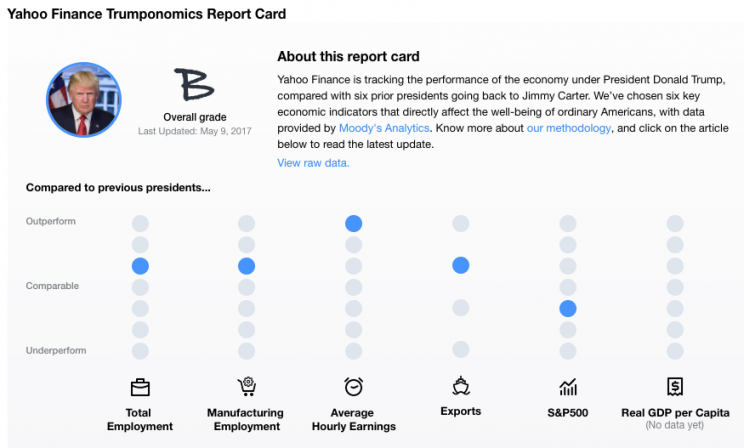Trumponomics Report Card: Methodology
The Yahoo Finance Trumponomics Report Card measures the performance of the economy under President Donald Trump, compared with its performance under other presidents going back to Jimmy Carter in the 1970s. We have developed a methodology meant to be both rigorous and intuitive, and we aim to be as transparent as possible about how we measure Trump’s performance on the economy during his time in office.
We chose the following six economic indicators as proxies for the health of the overall economy:
Employment, which reflects job growth.
Manufacturing employment, which measures job growth in a key sector that Trump himself has identified as a priority.
Average hourly earnings, adjusted for inflation, which reflects the extent to which American workers are getting ahead.
Exports, another Trump priority, which measures the quantity of goods and services American producers sell outside the United States.
The S&P 500 index, which measures the performance of the stock market.
Real GDP per capita, which measures economic growth relative to the size of the US population.
Moody’s Analytics is providing the data, organized in a way that allows apples-to-apples comparisons with prior presidents. We are comparing Trump’s first term with the first terms of other presidents, since policy changes likely to affect the economy tend to occur in a new president’s first four years. So we are measuring the Trump economy against the economy under Barack Obama starting in 2009, George W. Bush starting in 2001, Bill Clinton starting in 1993, George H. W. Bush starting in 1989, Ronald Reagan starting in 1981 and Jimmy Carter starting in 1977.
All of this data is publicly available, published by the Bureau of Labor Statistics, the Census Bureau and the Bureau of Economic Analysis—all government agencies—along with Standard & Poor’s. Moody’s Analytics has crunched the data for Yahoo Finance, and applied its own methodology to the creation of indexes for four of the indicators. Eventually, the report card will show charts representing how the presidents compare, when you hover over each indicator. We are developing the report card in phases and plan to have this feature available soon.
For five of the six indicators—the two employment measures, earnings, exports and stocks—the data is published monthly, and we tally the data using February of each president’s first year as the starting point. For GDP, which is reported quarterly, we use the first quarter of each president’s first year as the starting point.
For the two employment measures, we use the cumulative sum of new jobs created since the starting point. For the other four indicators, Moody’s Analytics has created an index, with the first month representing 100. Each president’s performance is then reported as the change from the starting point. This allows us to place the Trump economy on a spectrum bounded by the best and worst performing presidents for each indicator.
For five of the six indicators, there are 7 possible points on the spectrum, represented by the 7 dots you see on the report card: the Trump numbers, along with those for six prior presidents. For exports, the data only goes back to 1993, so there are only 4 dots on the spectrum: the numbers for Trump, Obama, George W. Bush and Clinton. Here’s our initial assessment, from mid-May, 2017, as a guide:

To convert the economic data to letter grades, we calculated the total number of Trump “dots” as a portion of the total possible number of dots. In the near future, when we have data for all indicators, the highest possible total will be 7 dots in each of 5 categories, and 4 dots in the remaining category: (5×7) + (1×4), or 39. Since we don’t have data yet for GDP, the highest possible total number of dots now is 7 dots in each of 4 categories and 4 dots in 1: (4×7) + (1×4), or 32.
To determine Trump’s grade, we divide the number of Trump dots by the total possible, coming up with a percentile between 0% and 100%. In our initial report card above, for instance, we’re only using 5 of the 6 indicators, because the relevant GDP data won’t be available until late July. Of those 5 categories, Trump earned 5 dots each for employment and manufacturing employment, 7 for earnings, 3 for exports and 3 for the S&P 500. That adds up to 23 dots, out of 32 possible, placing Trump in the 72nd percentile, overall, relative to the other presidents.
To convert percentiles into letter grades, we begin with the principle that the 50th percentile, relative to other presidents, represents a C grade. Then we spread the grades out evenly across the full range of possible outcomes. Here’s our complete grading range for the current data:


We believe this methodology is fair and transparent, yet we also realize it doesn’t account for every development that can affect the direction of the economy. The business cycle has natural swings, and it’s important to keep in mind the five recessions that occurred during the time we’re analyzing, which, according to the National Bureau of Economic Research, were:
January 1980 – July 1980
July 1981 – November 1982
July 1990 – March 1991
March 2001 – November 2001
December 2007 – June 2009
Other factors affecting the economy include abrupt swings in the price of commodities such as oil, wars, and other events presidents generally can’t control. We welcome debate over our report card and invite our audience to leave comments below, or reach out via our Twitter or Facebook feeds.
Rick Newman is the author of four books, including Rebounders: How Winners Pivot from Setback to Success. Follow him on Twitter: @rickjnewman. He’s reachable at [email protected].
